Great video of climbing to the royal yard on the Charles W. Morgan.
If you are having a lousy Monday, here is a reminder that things could always be worse. Below is a video of $24 million yacht, 102′ long, M/V Polar Bear, which caught fire last Thursday in Chula Vista, near San Diego, CA. The cause of the fire has yet to be determined, but there are reports that a welder was working aboard just before the blaze broke out. The yacht reportedly took five years to build and has been in service for only three years. The owner, understandably, is described as “devastated.”
Yesterday, a group of admirers gathered in Bow, England to celebrate the life and work of Cecily Fox Smith. She was a Victorian poet best remembered for her poems about ships and sailors in the last days of the age of sail. She wrote more than 600 poems which were published in more than two dozen volumes. The March 27, 1915 edition of the Spectator magazine reviewed her book “Sailortown” saying, “No one, not even Mr. Masefield, has written finer sea ballads or come closer to the heart of those who go down to the great waters.” AlPoetry.com has a wonderful collection of her work available online.
In recent years, her work has seen a revival as her poems have inspired musicians to write music to her verses. Over 70 of her poems have been adapted as songs. Here are two examples:
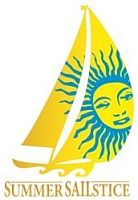 What is the best way to celebrate sailing? My first response is to say, go sailing. Sailing, seems to me, to be its own celebration. There is that moment when everything falls into balance — when the force of the wind on the sails, the lift of water flowing across the keel, the drag of the eddies boiling off the hull — when you can feel the perfect equilibrium of all the forces of the sea and sky in the gentle tug on the tiller or wheel. That instant is, for me at least, the perfect celebration of sailing.
What is the best way to celebrate sailing? My first response is to say, go sailing. Sailing, seems to me, to be its own celebration. There is that moment when everything falls into balance — when the force of the wind on the sails, the lift of water flowing across the keel, the drag of the eddies boiling off the hull — when you can feel the perfect equilibrium of all the forces of the sea and sky in the gentle tug on the tiller or wheel. That instant is, for me at least, the perfect celebration of sailing.
OK, enough rhapsodizing. My thoughts were triggered by an organization and a series of events referred to as Summer Sailstice. What is Summer Sailstice? According to its website, it is “a worldwide celebration of sailing on the weekend closest to the summer solstice – this year the solstice falls on a Saturday, June 21, 2014!” OK. Perhaps I am being more dim than usual, but that still doesn’t quite answer the question. Digging a bit deeper I find that, “Summer Sailstice was founded in February 2001 by John Arndt, as the global, annual celebration of sailing held on the summer solstice.
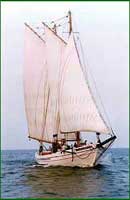 I wish that I had been sent to a summer camp aboard a historic schooner when I was a kid. Growing up in Texas, I remember summer camps notable for scrub mesquite trees, cactus and snakes, only some of which were poisonous. But I digress. This summer the 1928 Delaware Bay Oyster Schooner, AJ Meerwald will be offering a variety of sailing camp programs for children between the ages of 10 and 17. These programs range from one-day “Sailor For A Day Camp” to 5-day, 4-night shipboard experiences in their “Maritime Camp.” Click here to learn more.
I wish that I had been sent to a summer camp aboard a historic schooner when I was a kid. Growing up in Texas, I remember summer camps notable for scrub mesquite trees, cactus and snakes, only some of which were poisonous. But I digress. This summer the 1928 Delaware Bay Oyster Schooner, AJ Meerwald will be offering a variety of sailing camp programs for children between the ages of 10 and 17. These programs range from one-day “Sailor For A Day Camp” to 5-day, 4-night shipboard experiences in their “Maritime Camp.” Click here to learn more.
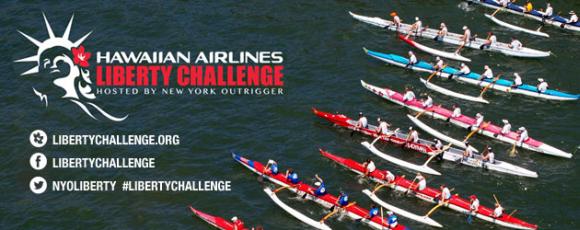 I will admit that it was news to me that the Hawaiian Airlines Liberty Challenge hosted by New York Outrigger is the largest outrigger regatta on the East Coast. Over 400 athletes from around the world are participating. According to the New York Outrigger website, “since 1997, the Liberty Challenge has grown to become one of the most prestigious outrigger canoe races in the world. The race is unique among world outrigger regattas as it takes place in a bustling urban harbor.
I will admit that it was news to me that the Hawaiian Airlines Liberty Challenge hosted by New York Outrigger is the largest outrigger regatta on the East Coast. Over 400 athletes from around the world are participating. According to the New York Outrigger website, “since 1997, the Liberty Challenge has grown to become one of the most prestigious outrigger canoe races in the world. The race is unique among world outrigger regattas as it takes place in a bustling urban harbor.
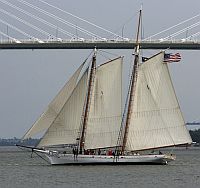 Last month we posted that the Sailing School Vessel Spirit of South Carolina was finally going to auction. For the last several years, the schooner been owned by TD Bank. Yesterday, the 140′ wooden schooner was sold at auction for $440,000 to two Charleston businessmen, Tommy Baker and Michael Bennett. In the short term, the new owners say that they will keep the schooner in Charleston, while they work out their longer term plans for the vessel. The schooner was constructed between 2001 and 2007 at a cost of $4 million dollars.
Last month we posted that the Sailing School Vessel Spirit of South Carolina was finally going to auction. For the last several years, the schooner been owned by TD Bank. Yesterday, the 140′ wooden schooner was sold at auction for $440,000 to two Charleston businessmen, Tommy Baker and Michael Bennett. In the short term, the new owners say that they will keep the schooner in Charleston, while they work out their longer term plans for the vessel. The schooner was constructed between 2001 and 2007 at a cost of $4 million dollars.
 In the last decade, ten people off Western Australia have been attacked and killed by sharks. All of the deaths have been attributed to attacks by great white sharks. Earlier this year, the government of Australia set out on a trial program to “cull” dangerous sharks, targeting, in particular, great whites. The initial results were not encouraging.
In the last decade, ten people off Western Australia have been attacked and killed by sharks. All of the deaths have been attributed to attacks by great white sharks. Earlier this year, the government of Australia set out on a trial program to “cull” dangerous sharks, targeting, in particular, great whites. The initial results were not encouraging.
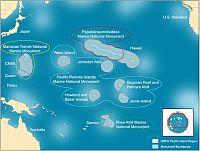 In 2006, President George W. Bush created three marine national monuments in the Pacific Ocean. Today, President Obama announced the dramatic expansion of these marine preserves to form the world’s largest marine sanctuary. Under the proposal, the Pacific Remote Island Marine National Monument would grow from almost 87,000 square miles to nearly 782,000 square miles — all of it adjacent to seven islands and atolls controlled by the United States. The sanctuary covers a broad swath of the central Pacific Ocean and will be off-limits to fishing, energy exploration and other activities. The proposal is slated to go into effect later this year and could double the area of the ocean globally that is fully protected.
In 2006, President George W. Bush created three marine national monuments in the Pacific Ocean. Today, President Obama announced the dramatic expansion of these marine preserves to form the world’s largest marine sanctuary. Under the proposal, the Pacific Remote Island Marine National Monument would grow from almost 87,000 square miles to nearly 782,000 square miles — all of it adjacent to seven islands and atolls controlled by the United States. The sanctuary covers a broad swath of the central Pacific Ocean and will be off-limits to fishing, energy exploration and other activities. The proposal is slated to go into effect later this year and could double the area of the ocean globally that is fully protected.
“I’m going to use my authority to protect some of our nation’s most precious marine landscapes,” Obama said in a video to participants at a State Department conference, adding that while the ocean is being degraded, “We cannot afford to let that happen. That’s why the United States is leading the fight to protect our oceans.”
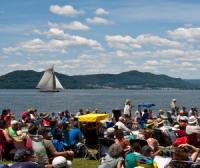 The days around the summer solstice will be a busy time on the Hudson River. We recently posted about the North River Historic Ship Festival on the Hudson River Park’s Pier 25 in Lower Manhattan from Friday, June 20 to Tuesday June 24.
The days around the summer solstice will be a busy time on the Hudson River. We recently posted about the North River Historic Ship Festival on the Hudson River Park’s Pier 25 in Lower Manhattan from Friday, June 20 to Tuesday June 24.
Roughly 50 miles upriver at Croton Point Park in Croton-On-Hudson, NY, on June 21-22, the Clearwater Great Hudson River Revival will be celebrating the Hudson River with music, food, crafts and sailing on the sloop Clearwater or schooner Mystic Whaler. TheClearwater Festival is the country’s oldest and largest music and environmental festival, bringing together major musical acts and Clearwater’s own brand of green activism.
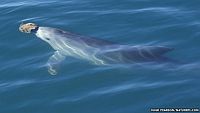
Sponger photo: Hugh Pearson/Naturepl.com
While it was long thought that only humans made and used tools, we now know that a variety of apes and monkeys are toolmakers. Elephants, crows, sea otters and octopus have also been observed making tools. Now, we can add dolphins to the list.
Recently, scientists discovered Indo-Pacific bottlenose dolphins in Shark Bay off the coast of Australia apparently use tools. They carry sponges on their snouts which may help protect their sensitive beaks from sharp rocks and other hazards as they probe the seafloor for food. Scientists report that more than 60 percent of all female dolphins practice sponging, and up to half of all males born to “spongers” in one part of the bay grow up to become spongers themselves. The scientists also discovered that the sponger and non-sponger dolphins had dramatically different diets. The sponging dolphins apparently have access to different foods than the non-spongers.
Two wonderful videos by Mystic Seaport Museum of the whaler Charles W. Morgan under sail, preparing for her 38th voyage.
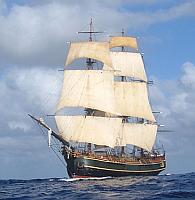 The Coast Guard has issued its final report on the sinking of HMS Bounty in October 2012. You can read the report here.
The Coast Guard has issued its final report on the sinking of HMS Bounty in October 2012. You can read the report here.
In the report, there is one oblique reference to 1998 in which “the Seventh Coast Guard District closed the marine casualty case after having determined that BOUNTY was not a commercial vessel.” The casualty referred to was when the Bounty had come perilously close to sinking, in almost the same waters where she sank in 2012, and for almost the same reasons.
Not quite 20 years ago, I sailed only once, and briefly, with Captain Robin Walbridge on HMS Bounty on a re-positioning leg from New York to Newport, Rhode Island. Continue reading
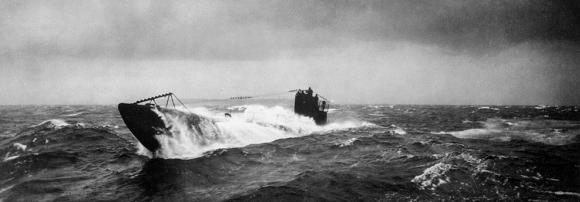 The Atlantic Monthly has a wonderful feature this month — World War I in Photos: The War at Sea by Alan Taylor. Moving troops and supplies by sea was vital to all armies involved in the war. The battle for control of the seas led to an arms race, new deadly tactics, and unprecedented loss of life at sea. Click here for more.
The Atlantic Monthly has a wonderful feature this month — World War I in Photos: The War at Sea by Alan Taylor. Moving troops and supplies by sea was vital to all armies involved in the war. The battle for control of the seas led to an arms race, new deadly tactics, and unprecedented loss of life at sea. Click here for more.
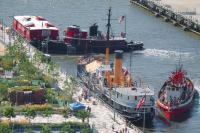
Photo : Milo Hess
The North River Historic Ship Festival is returning for the sixth year to Hudson River Park’s Pier 25 in Lower Manhattan from Friday, June 20 to Tuesday June 24. The festival will offer 500 free boat rides aboard historic vessels, hands-on tours of museum ships, a showboat circus, fishing on the pier, a party on a wooden barge, and more! The festival will welcome thousands of people to Hudson River Park’s Pier 25 at N. Moore Street and the Hudson River to celebrate the Summer Solstice. The historic vessels and their salty captains will help tell the story of what was once a busy commercial riverfront. To learn more, click here.
 The historic lighthouse tender Lilac is celebrating the Summer season with a exhibition of Jonathan Atkin’s Hero Project. Hero Project is a selection from Jonathan’s on-going work-in-progress collaboration with dance artists aboard historic ships. His mission is to increase visibility of our maritime heritage by reaching new non-maritime audiences. In the exhibition, dancers athletically grace the gritty vessels in oversize photographs mounted throughout Lilac, from the bridge to the engine room. From the Hero Project website: This project is no fashion shoot. Nor a model shoot. It is not a ship shoot. It is a poem, a ballad, a celebration of historic ships through the energy of dance and dancer’s perceptions that may encourage the public to navigate through the fog of underappreciation for both historic ships and dancers. Both historic ships representing our neglected maritime heritage and dancers, are HEROES!
The historic lighthouse tender Lilac is celebrating the Summer season with a exhibition of Jonathan Atkin’s Hero Project. Hero Project is a selection from Jonathan’s on-going work-in-progress collaboration with dance artists aboard historic ships. His mission is to increase visibility of our maritime heritage by reaching new non-maritime audiences. In the exhibition, dancers athletically grace the gritty vessels in oversize photographs mounted throughout Lilac, from the bridge to the engine room. From the Hero Project website: This project is no fashion shoot. Nor a model shoot. It is not a ship shoot. It is a poem, a ballad, a celebration of historic ships through the energy of dance and dancer’s perceptions that may encourage the public to navigate through the fog of underappreciation for both historic ships and dancers. Both historic ships representing our neglected maritime heritage and dancers, are HEROES!
The Hero Project will be on display aboard the Lilac through June 30. The Lilac is moored at Pier 25 in Manhattan on the Hudson River. Click here for directions and event hours.
There is a story that has been floating around the web about a 19 year old Dutch engineering student, Boyan Slat, who, if you believe the claims, has figured out how to clean almost half of the Great Pacific garbage patch in only ten years. At the risk of sounding cynical, the first thing that came to mind was the “super-skimmer” A-Whale, a converted Ore-Bulk-Oiler which was supposed to have revolutionized oil spill clean-up, if only it had worked, which it didn’t. Likewise, the operative question for Boyan Slat’s concept, is, will it work?
The Great Pacific garbage patch is the name given to floating mass of plastic and other waste caught in the Northern Pacific gyre, a huge circular current in the Northern Pacific. Slat’s idea is to use a series of floating barriers anchored to the ocean floor to use the force of the current to filter and concentrate the plastic waste.
Boyan Slat: Why would you move through the oceans if the oceans can move through you?
There is considerable skepticism about whether Slat’s anchored arrays would work. Continue reading
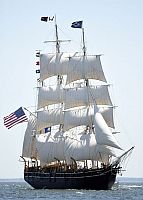
Sean D. Elliot/The Day
Yesterday, the Charles W. Morgan set sail for the first time in almost a century. The whaling ship built in 1841 has been extensively rebuilt at Mystic Seaport Museum and successfully completed its first day of sea trials in Long Island Sound off New London. Sea trials are continuing today and on June 11, and 12.
Click here for more photos of the Morgan under sail at The Day.
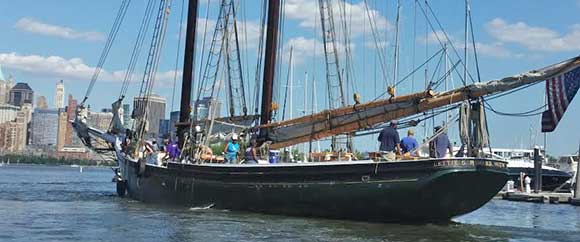
Photo: K. Lorentz
Yesterday, while maneuvering our 18′ catboat through the traffic in the Morris Canal on the West bank of the Hudson off Lower Manhattan, we had the pleasure of crossing paths with the schooner Lettie G. Howard. Lettie is an 1893 Fredonia-model fishing schooner owned and operated by the South Street Seaport Museum. It is great to see her back in the harbor.
In early 2012, the schooner was docked to repair rot in her keelson. The rot turned out to be far more extensive than originally thought. Despite all the other challenges facing the institution, the museum successfully raised the $250,000 necessary to repair the Lettie and put her back into service. Almost a month ago, the Lettie G. Howard was ceremonially re-launched at Manhattan’s Pier 25 on the Hudson River. She is operating as a sailing school vessel instructing students of the Urban Assembly New York Harbor School on Governors Island and New Jersey’s Marine Academy of Science and Technology at Sandy Hook.
A recent news story and video spins a fascinating mystery. Scientists in Australia tagged a healthy 9-foot great white shark. Four months later they found the tracking device washed up on a beach. The data in the the tracking device was bizarre. It recorded a rapid temperature rise and a sudden 1,900-foot-deep plunge. The tracking device stayed there for many days, moving around and occasionally ascending to go down again until it finally reached the shore. It appears that the great white shark had been swallowed by an even larger and more fearsome predator. A video from the Smithsonian Channel:
Something Ate This Shark… But What?
So what did eat the great white?
Update: Apparently in this case, scientists have determined that a much larger great white shark, perhaps 16′ long or so, probably ate the 9′ Continue reading
